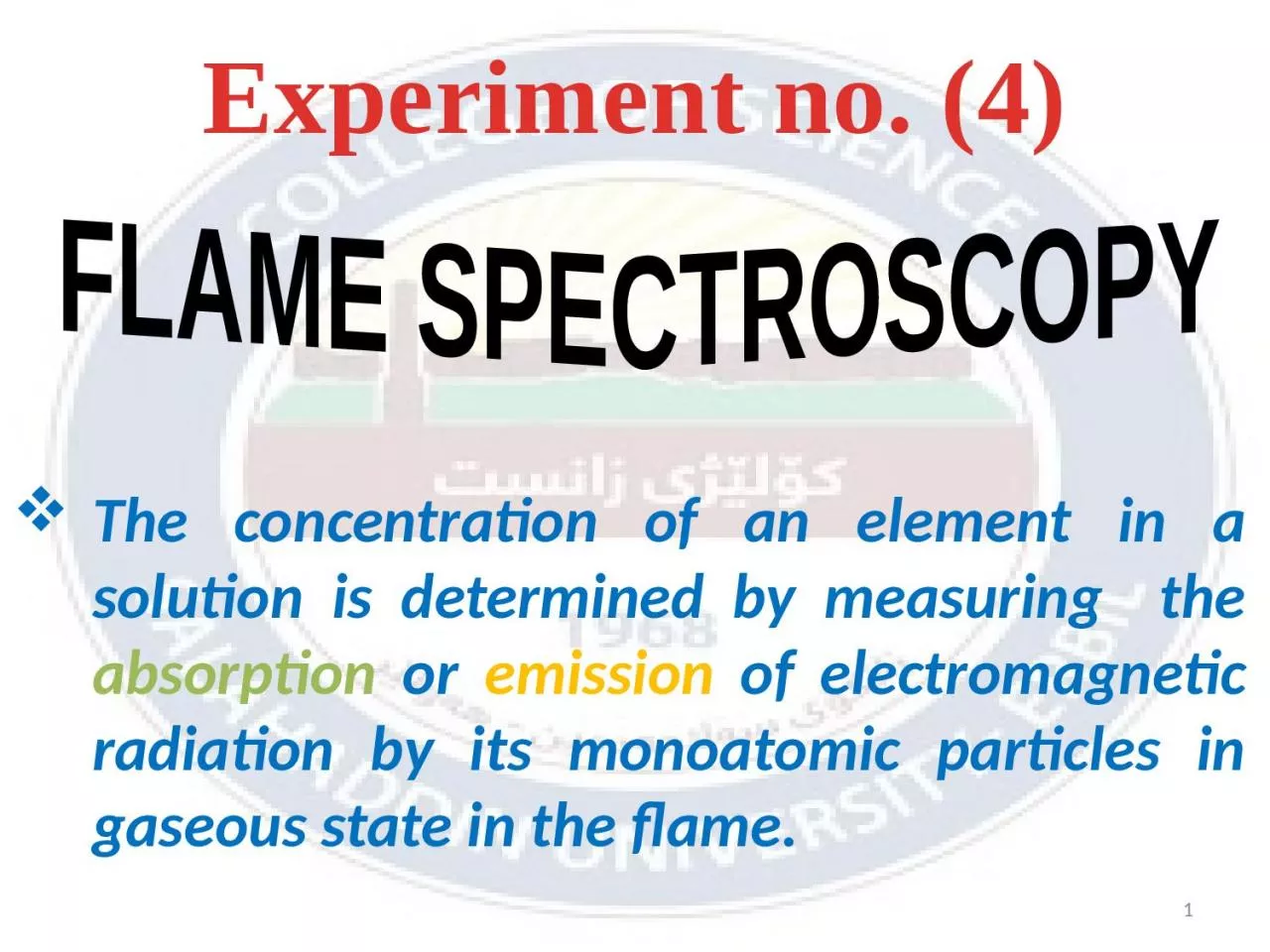

absorption or emission of electromagnetic radiation by its monoatomic particles in gaseous state in the flame FLAME SPECTROSCOPY 1 Experiment no 4 Atoms in gaseous state in the flam ID: 1022390
Download Presentation The PPT/PDF document "The concentration of an element in a sol..." is the property of its rightful owner. Permission is granted to download and print the materials on this web site for personal, non-commercial use only, and to display it on your personal computer provided you do not modify the materials and that you retain all copyright notices contained in the materials. By downloading content from our website, you accept the terms of this agreement.
1. The concentration of an element in a solution is determined by measuring the absorption or emission of electromagnetic radiation by its monoatomic particles in gaseous state in the flame.FLAME SPECTROSCOPY 1Experiment no. (4)
2. Atoms in gaseous state in the flam absorb thermal energy from the flame itself ,some of the atoms get excited & as they return back to the ground state they emit radiation having energy equal to that absorbed. The emission is proportional to the number of excited atoms, which is proportional to the total number of atoms in the flame i.e. the sample concentration. Flame Emission Na Na * Na * Na + hνProportional to conc.Energy from flame 2
3. Flame photometry: is an atomic emission method for the routine detection of metal salts , principally Na, K, Li, Ca and Ba . The method is selective to ward detection of alkali and alkaline earth metals and simple, inexpensive, used for clinical, biological ,and environmental analysis. Flame photometry has limited application because the temperature of flame is not high enough to atomize and excite transition metals or other metals.3
4. 1-Flame atomizer with the Sample.2- Wavelength selector (Filter or Monochromator)3- Detector.4- Readout (meter).INSTRUMENT FOR FLAME EMISSION 4
5. sampleoxidantfuelflamemonochromatorPhoto multiplierDc amplifierrecorderFlame photometry diagram5
6. The temperature of the flame produced depends on (fuel-oxidant ) ratio and its kinds Fuels OxidantsHydrogen AirAcetylene OxygenPropaneNitrous oxideNatural gasAir6
7. 1- The solvent is evaporated leaving minute particles of dry salt (S). 2- The dry solids are converted into the gaseous state.3- A part of all the gaseous molecules are dissociated to give neutral atoms or radicals. The atomization step.4-A portion of the neutral atoms may be thermally excited.5-Some of the neutral atoms may combine with radicals in the flame gases to form new gaseous compounds. The process that done inside the flame 7
8. Sample nebulization desolvated Vaporized Atomized hνreturn to a lower ground stat excited electronic state (Flame photometry) • Those which are activated (excited) will drop back to ground state with the emission of a photon of radiation which can be identified and measured with a suitable (flame photometry). The process that done inside the flame:8
9. 1. Preparation of Stock solution: Prepare (100 ppm) of Na+ from NaCl in (250 ml). Prepare (100 ppm) of K+ frome KCl in (250 ml).2. Preparation of Calibration Curve: - Prepare (5,10,15, 20, 25 ppm) of Na+ from the stock solution, Complete the volume to (50 ml) by (D.W.). - Prepare (10, 20, 30, 40, 50 ppm) of K+ from the stock solution Complete the volume to (50 ml) by (D.W.).Procedure9Exp. No. (4) Determination of sodium and potassium in soil by flame photometry
10. 3. Preparation of the unknown: Weight (2 g) of soil, add (5 ml) of conc. HCl heat for (2 min), add a few drops of (D.W.) and filter the solution then complete the volume to (50 ml).4. Set the instrument to read 100% for the most concentrateNa+ solution, determine the intensity of the other Na+ solution as compared to this. Run of sample.5. Set the instrument to 100% with the most concentrated K+Solution. Read the intensity of the K+ solutions as comparedto this. Run an unknown sample.6. Determine the concentration of Na+, K+ in the sample. 10
11. Calibration curve for Na or K Emission %Conc. ppm ( Na )conc. unknown11